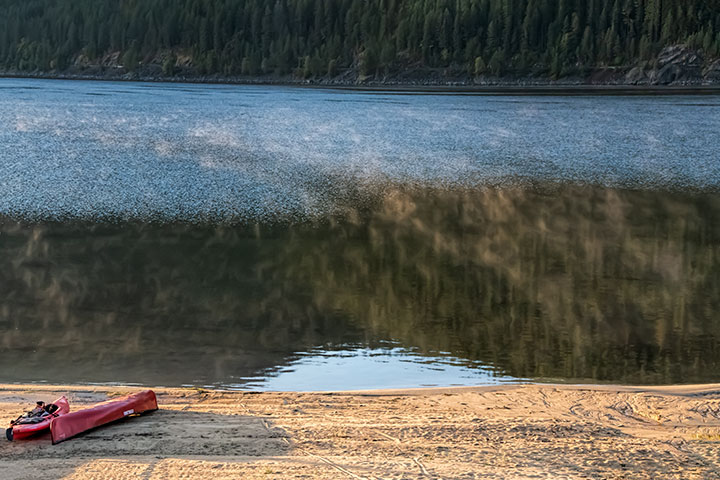As the sun rose yesterday, a neat choreography of a katabatic wind created ephemeral sprites of steam fog, and abruptly ruffled calm waters farther offshore. In fifteen minutes, it was all over.
Katabatic wind
The night had been clear, so the infrared radiation lost by the ground was not offset by compensating radiation from the clouds. The mountainside cooled, which in turn caused the adjacent air to cool and begin to flow downslope. This drainage wind is called a katabatic wind, but it is usually so gentle as to be almost undetectable. Upon reaching the valley bottom, the air moved out over the Lake.
Temperature difference
The katabatic air flowing out over the Lake was cooler than the centimetres-thick air already over the water. Certainly, the Lake had also lost energy by infrared emission, but convection in the water had brought warmer water from below to the surface and kept the adjacent air warm. It also kept this thin layer of air moist.
Steam fog
There are two distinct mechanisms that can produce condensation. The best known is vapour cooling. This is responsible for the formation of cumulus clouds and wave clouds. (It is usually explained by saying that cold air cannot hold as much water vapour as warm air, but this glib assertion has been known to be nonsense for over two centuries.) The mechanism for the formation of the steam fog seen here was that of vapour mixing. There was no net temperature change as warm and cool vapour from two sources mixed. (This mechanism also gives rise to the contrails trailing the engines of jet planes.) As the katabatic wind, with its cool vapour, flows over the surface air of the Lake, with its warm vapour, the condensation forms little convective towers of steam fog that drift with the wind.
Surface transformation
As if the katabatic wind and the formation of steam fog were not interesting enough, something else odd took place. Lines of the steam-fog sprites trace the air flow offshore. Initially the wind does not ruffle the water’s surface — then abruptly, a little way out, it does. This pattern is strikingly consistent across the Lake: smooth water abruptly transforms into ruffled water.
Wave threshold
We are used to seeing the wind drag on a water surface and raise waves. However, waves on water have a minimum speed of 23 cm/s. If the wind is gentler than this (or if a swimming bug moves slower than this), no waves are created. The katabatic wind flowing down the mountainside has been slowed by trees. But, as the air moves out over the water, it accelerates and at the threshold number of 23 cm/s, it begins to abruptly ruffle the water’s surface as it can now create waves.
Termination
This waltz between wind, water, and waves originated with a cooling of the mountainside by the net loss of infrared radiation. It ended quickly when the rising sun began to warm the mountainside. This killed the katabatic wind, and over a period of only a few minutes, the air stopped flowing out over the water, the steam fog vanished, and the Lake became calm.
Thank you for the dance.
A katabatic wind flows over warmer water making steam fog and ruffling the water offshore.


Impressive
Yes Alistair, thank you for the dance indeed. This reminds me, again, of another lake, another time: Seton Lake in the BC Interior, surrounded by mountains and tunnel-fed from Carpenter Lake, creating a dance of green mist, green sprites, and a wonderland of steam-fog. Dipping a toe into the water any time before August and the shock is apparent, and similar to Kootenay Lake — in other words, incredibly cold.
It creates a very pretty picture.
“It is usually explained by saying that cold air cannot hold as much water vapour as warm air, but this glib assertion has been known to be nonsense for over two centuries.”
Hmmm. I’ll have to look into this.
Trevor, chuckle, go for it.
Mind you, the air-holding-water-vapour line is so common that it might be difficult to find something different outside of academic circles.
The basic insight into the issue goes back to 1802 when John Dalton published his law of partial pressures. It correctly noted that the gases in a mixture act independently. Prior to that, people thought that water vapour was dissolved in air (Nitrogen and Oxygen) rather as sugar might be dissolved in water. However, dissolution depends upon a bond between the solvent and solute, and as Dalton noted, that does not exist in a mixture of gases (at normal temperatures and pressures).
Despite this, the eighteenth-century thinking is still offered in classrooms nearly three hundred years later. Indeed, I have even encountered a chemistry teacher who would tell his students about Dalton’s Law and then later in the course say that clouds form because cold air cannot hold as much water vapour as warm air. His students should have responded with a resounding, HUH? However, the students were not struck by the inconsistency any more than was the teacher. Sigh….
The phase changes of water are a consequence of the properties of water. The (rest of the) air has nothing to do with it. If it were really true that condensation depended upon the holding power of air, then our weather would be rather different: everything from hurricanes, to mid-latitude precipitation, to fog, to frost, to avalanches, to winter sports such as skiing would be different (the properties of snow would change).